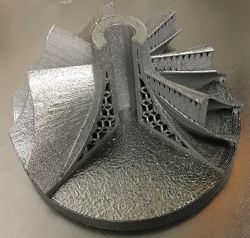Additive manufacturing (AM) such as for example Selective Laser Melting (SLM) enables generative manufacturing of metallic components from digital models (e.g. CAD files) and alloy powders. The new AM technologies are steadily leading a paradigm change in design and production of metallic parts in various areas of daily life from transport to medical implants. Additive manufacturing opens up fundamentally new possibilities for part design and construction and enables more complex geometries, incorporating e.g. internal structures or bionic designs that were heretofore either too resource intensive or simply inaccessible for conventional manufacturing technologies.
Selective Laser Melting, which is the AM technology primarily used at DLR, belongs to the so called powder-bed methods that build parts up layer-by-layer, i.e. generatively. The powder, which is deposited in layers of 20 to 100 µm height on a base plate, is locally melted by a laser. Subsequent layers are deposited and melted until the metallic part is completed.
The research and development activities in this area cover the processing strategies for existing conventional alloys as well as the development and processing of novel alloys that are being custom-designed for the unique metallurgic conditions faced in AM. The conventional alloys being studied include titanium alloys, nickel alloys and titanium aluminides widely used in the aerospace sector. The latter possess great potential for high-temperature applications (operating temperatures of up to 700 °C in contrast to typically less than 550 °C for titanium alloys) in e.g. turbine engines, stationary gas turbines or turbo chargers.
The mechanical performance of AM alloys depends strongly on the processing conditions, the obtained microstructures, compositions and thermo(-mechanical) treatments. The materials obtained as well as the used alloy powders are characterized extensively with laboratory methods (e.g. SEM, TEM, XRD, EBSD etc.) as well as synchrotron/neutron imaging and diffraction based methods (Fig. 1). The achieved fundamental understanding of the interplay between microstructures and mechanical properties enables the furthering of the processing and posttreatment strategies. In cooperation with other institutes of the DLR, the gained knowledge is integrated in the design, development and testing of AM components for the aeronautic and aerospace sectors.
Subscribe to AM Chronicle Newsletter to stay connected: https://bit.ly/3fBZ1mP
Follow us on LinkedIn: https://bit.ly/3IjhrFq
Visit for more interesting content on additive manufacturing: https://amchronicle.com


